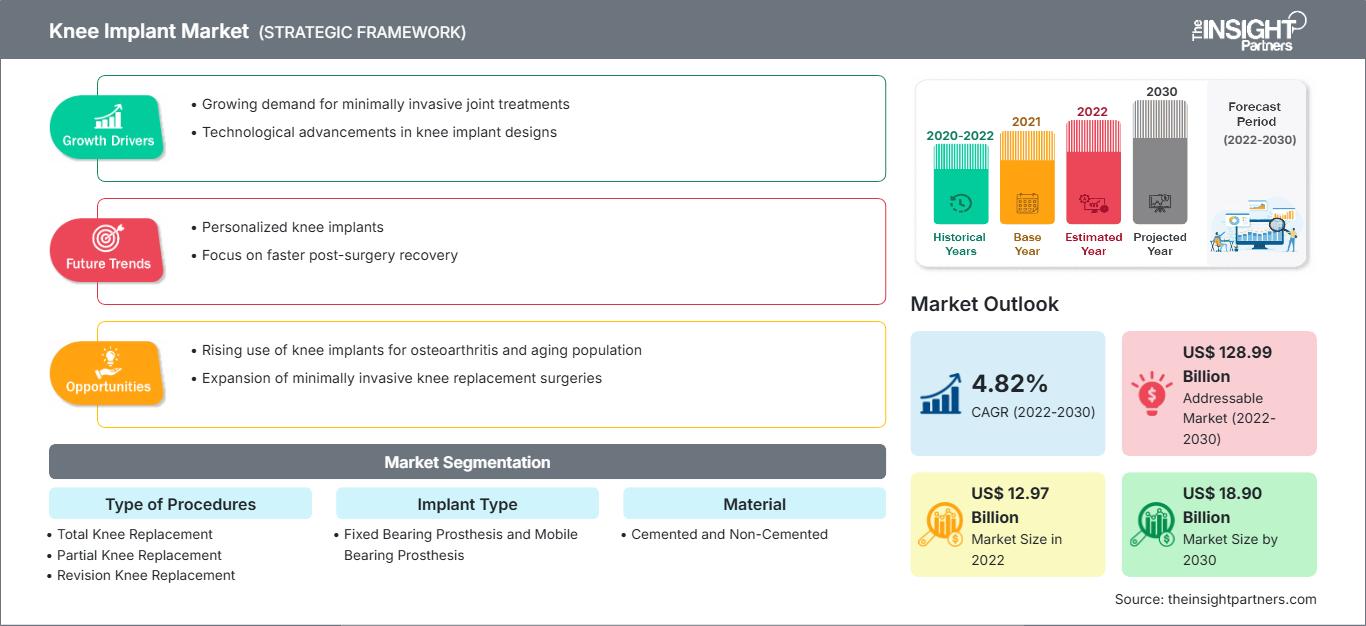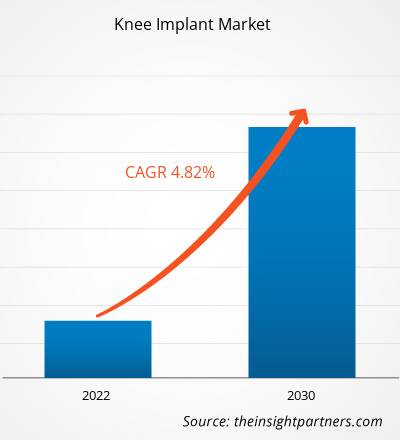膝关节植入物市场规模预计将从 2024 年的 140.8 亿美元增至 2031 年的 198.2 亿美元。预计 2025 年至 2031 年期间该市场的复合年增长率将达到 5.09%。
膝关节植入物市场分析
由于骨关节炎发病率上升和全球人口老龄化,膝关节植入物的需求日益增长。生物材料、3D打印和微创手术技术的创新提升了植入物的耐用性和患者体验。医疗保健意识的不断增强、支持性报销政策的推行以及定制化膝关节置换方案需求的不断增长,共同推动了市场的增长。
膝关节植入物市场概况
包括3D打印个性化植入物和微创外科手术在内的技术进步正在改善患者的治疗效果。医疗保健支出的增加、良好的报销政策以及新兴市场日益增强的认知度,使得膝关节植入物成为骨科医疗器械市场中一个至关重要的细分领域。
您将获得任何报告的免费定制,包括本报告的部分内容、国家级分析、Excel 数据包,以及为初创企业和大学提供优惠和折扣
膝关节植入物市场:战略洞察

- 获取此报告的顶级关键市场趋势。此免费样品将包括数据分析,从市场趋势到估计和预测。
膝关节植入物市场驱动因素和机遇
市场驱动因素:
- 人口老龄化:全球老龄人口的增加导致骨关节炎等退行性关节疾病的发生,这极大地影响了膝关节置换手术和植入物的需求。
- 技术进步:植入材料、机器人和 3D 打印技术的发展使得手术后效果更好、植入物的寿命更长、恢复时间更短,从而使患者更愿意接受膝关节置换手术。
市场机会:
- 新兴市场扩张:亚太地区和拉丁美洲等发展中地区由于医疗保健基础设施不断增长、收入不断增加以及对关节置换选择的认识不断提高,具有尚未开发的潜力。
- 个性化和定制植入物:对于使用先进成像和制造技术定制的患者专用植入物的需求正在不断增长,这些植入物可提供更好的贴合度、更好的功能以及更高的术后患者满意度。
膝关节植入物市场报告细分分析
为了更清晰地了解膝关节植入物市场的运营情况、增长潜力和当前趋势,我们将膝关节植入物市场细分为多个类别。以下是行业报告中使用的标准细分方法:
按程序类型:
- 全膝关节置换术
- 部分膝关节置换术
- 膝关节置换术
按植入物类型:
- 固定轴承假体
- 活动轴承假体
按材质:
- 骨水泥
- 非骨水泥
按最终用户:
- 医院
- 骨科诊所
- 门诊手术中心
- 其他的
按地理位置:
- 北美
- 欧洲
- 亚太地区
- 拉美
- 中东和非洲
膝关节植入物市场区域洞察
Insight Partners 的分析师已详尽阐述了预测期内影响膝关节植入物市场的区域趋势和因素。本节还讨论了北美、欧洲、亚太地区、中东和非洲以及南美和中美的膝关节植入物市场细分和地域分布。
膝关节植入物市场报告范围
| 报告属性 | 细节 |
|---|---|
| 2024年的市场规模 | 140.8亿美元 |
| 2031年的市场规模 | 198.2亿美元 |
| 全球复合年增长率(2025-2031) | 5.09% |
| 史料 | 2021-2023 |
| 预测期 | 2025-2031 |
| 涵盖的领域 | 按手术类型
|
| 覆盖地区和国家 | 北美
|
| 市场领导者和主要公司简介 |
|
膝关节植入物市场参与者密度:了解其对业务动态的影响
膝关节植入物市场正在快速增长,这得益于终端用户需求的不断增长,而这些需求的驱动因素包括消费者偏好的演变、技术进步以及对产品优势的认知度不断提升。随着需求的增长,企业正在扩展产品线,不断创新以满足消费者需求,并抓住新兴趋势,从而进一步推动市场增长。

- 获取膝关节植入物市场主要参与者概览
膝关节植入物市场份额(按地区)分析
膝关节植入物行业地域分布广泛,北美凭借其卓越的医疗质量、日益增长的骨关节炎病例以及技术相关的医疗保健优势,占据行业领先地位。紧随其后的是欧洲,老龄人口和医疗保险是影响市场的主要因素。亚太地区正在快速发展,这得益于该地区医疗保健投资的不断增长以及中国和印度人口的老龄化。此外,中东和非洲以及拉丁美洲也拥有潜在的骨科护理和可及性,但尚未得到充分开发。
由于人口老龄化和行动障碍患病率上升等因素,膝关节植入物市场的增长在不同地区存在差异,从而推动了对膝关节植入物治疗的需求。以下是各地区市场份额和趋势的总结:
1. 北美
- 市场份额:占据全球市场的很大份额
- 关键驱动因素:
- 老年人口不断增加
- 技术进步
- 趋势:门诊关节置换术
2.欧洲
- 市场份额:相当大的市场份额
- 关键驱动因素:
- 优惠的报销政策
- 老年人口不断增长
- 趋势:医疗旅游日益增长
3. 亚太地区
- 市场份额:增长最快的地区,市场份额每年都在增长
- 关键驱动因素:
- 扩大医疗保健服务
- 骨关节炎病例增加
- 趋势:国内制造业繁荣
4. 南美洲和中美洲
- 市场份额:市场稳步增长
- 关键驱动因素:
- 城市化与生活方式的改变
- 私营医疗服务日益壮大
- 趋势:健康保险增长
5.中东和非洲
- 市场份额:市场稳步增长
- 关键驱动因素:
- 医疗保健投资不断增加
- 延长寿命
- 趋势:骨科卓越中心
膝关节植入物市场参与者密度:了解其对业务动态的影响
市场密度高,竞争激烈
该市场竞争对手的优势之一是拥有知名的公司,其中我们可以提到 Zimmer Biomet 和 Stryker Corporation。
这种激烈的竞争促使公司通过提供以下产品脱颖而出:
- 高级产品
- 定制和可持续解决方案等增值服务
- 有竞争力的定价模式
- 遵守监管准则
机遇与战略举措
- 2024 年 6 月:Zimmer Biomet 与 THINK Surgical, Inc. 签署了分销协议,以扩大 TMINI 机器人膝关节系统的曝光度,用于机器人骨切割和 3D 规划。
- 2024 年 1 月:Zimmer Biomet 推出了 Persona IQ 智能膝关节植入物,可实时监测恢复情况。
在膝关节植入物市场运营的主要公司有:
- 齐默邦美控股公司
- 史密斯和侄子公司
- DePuy Synthes(强生医疗科技)
- 史赛克公司
- 美达克塔国际公司
- Conformis公司
- Arthrex公司
- Exactech公司
- 微创医疗科学有限公司
- 利马公司
- Enovis 公司(DJO Global)
- Aesculap 种植系统(B. Braun)
- 科林集团
- 美敦力公司
- 康美德公司
- THINK外科公司
- 联合骨科公司
- Maxx Orthopedics公司
- OrthAlign公司
- Exatech公司
免责声明:以上列出的公司没有按任何特定顺序排列。
研究过程中分析的其他公司:
- ARTIQO有限公司
- 特殊外科医院(HSS)
- 金名公司
- B. Braun SE
- Uteshiya Medicare
- Evonic医疗器械
- Physica System(微创医疗)
- SurgTech公司
- LINK骨科
- 内旋膝关节(MRK)
- 沃斯顿医疗器械公司
- BBRAUN 阿斯库拉普
- ATTUNE 膝盖(DePuy)
- 旅程 II(史密斯和侄子)
- K-MONO 系统(Medacta)
- GKS PRIME Flex TRASER
- 单室(Corin)
- 哥伦布(Aesculap)
- Optetrak Logic(Exactech)
- iUni(Conformis)
膝关节植入物市场新闻及最新发展
- 2024 年 10 月:Smith+Nephew 在美国推出 LEGION 铰链膝关节系统,目标是。
- 2023 年 3 月:史赛克推出 Mako Total Knee 2.0,推进膝关节置换智能机器人技术。
膝关节植入物市场报告覆盖范围和交付成果
《膝关节植入物市场规模及预测(2021-2031)》报告对以下领域进行了详细的市场分析:
- 膝关节植入物市场规模及全球、区域和国家层面所有主要细分市场的预测
- 膝关节植入物市场趋势,以及市场动态,如驱动因素、限制因素和关键机遇
- 详细的 PEST 和 SWOT 分析
- 膝关节植入物市场分析涵盖主要市场趋势、全球和区域框架、主要参与者、法规和最新市场发展
- 行业格局和竞争分析,涵盖市场集中度、热图分析、知名参与者以及膝关节植入物市场的最新发展
- 详细的公司简介
- 历史分析(2 年)、基准年、预测(7 年)及复合年增长率
- PEST和SWOT分析
- 市场规模、价值/数量 - 全球、区域、国家
- 行业和竞争格局
- Excel 数据集
近期报告
客户评价
购买理由
- 明智的决策
- 了解市场动态
- 竞争分析
- 客户洞察
- 市场预测
- 风险规避
- 战略规划
- 投资论证
- 识别新兴市场
- 优化营销策略
- 提升运营效率
- 顺应监管趋势




















 获取免费样品 - 膝关节植入物市场
获取免费样品 - 膝关节植入物市场